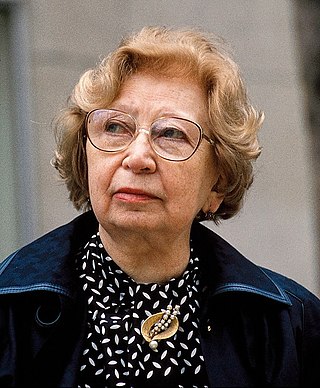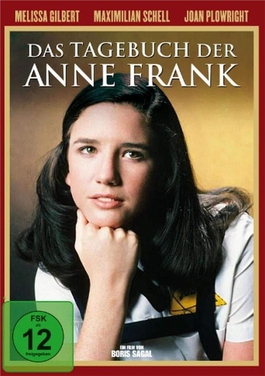
Otto Heinrich Frank was the father of Anne Frank. He edited and published the first edition of her diary in 1947 and advised on its later theatrical and cinematic adaptations. In the 1950s and the 1960s, he established European charities in his daughter's name and founded the trust which preserved his family's wartime hiding place, the Anne Frank House, in Amsterdam.

The Diary of Anne Frank is a 1959 American biographical drama film based on the Pulitzer Prize-winning 1955 play of the same name, which was in turn based on the posthumously published diary of Anne Frank, a German-born Jewish girl who lived in hiding in Amsterdam with her family during World War II. It was directed by George Stevens, a Hollywood filmmaker previously involved with capturing evidence of concentration camps during the war, with a screenplay by Frances Goodrich and Albert Hackett. It is the first film version of both the play and the original story, and features three members of the original Broadway cast.

Hermine "Miep" Gies was one of the Dutch citizens who hid Anne Frank, her family and four other Dutch Jews from the Nazis in an annex above Otto Frank's business premises during World War II. She was Austrian by birth, but in 1920, at the age of eleven, she was taken in as a foster child by a Dutch family in Leiden to whom she became very attached. Although she was only supposed to stay for six months, this stay was extended to one year because of frail health, after which Gies chose to remain with them, living the rest of her life in the Netherlands.

Annelies Marie "Anne" Frank was a German-born Jewish girl who kept a diary documenting her life in hiding amid Nazi persecution during the German occupation of the Netherlands. A celebrated diarist, Frank described everyday life from her family's hiding place in an Amsterdam attic. She gained fame posthumously and became one of the most-discussed Jewish victims of the Holocaust with the 1947 publication of The Diary of a Young Girl, which documents her life in hiding from 1942 to 1944. It is one of the world's best-known books and has been the basis for several plays and films.

Karl Josef Silberbauer was an Austrian police officer, Schutzstaffel (SS) member, and undercover investigator for the West German Bundesnachrichtendienst. He was stationed in Nazi-occupied Amsterdam during World War II, where he was promoted to the rank of Hauptscharführer. In 1963, Silberbauer, by then an inspector in the Vienna police, was exposed as the commander of the 1944 Gestapo raid on the Anne Frank House Secret Annex and the arrests of Anne Frank, her fellow fugitives, and two of their protectors, Victor Kugler and Johannes Kleiman.

Margot Betti Frank was the elder daughter of Otto Frank and Edith Frank and the elder sister of Anne Frank. Margot's deportation order from the Gestapo hastened the Frank family into hiding. According to the diary of her younger sister, Anne, Margot kept a diary of her own, but no trace of it has ever been found. She died in Bergen-Belsen concentration camp from a typhus outbreak.

Friedrich "Fritz" Pfeffer was a German dentist and Jewish refugee who hid with Anne Frank and her family and the Van Pels family during the Nazi occupation of the Netherlands. He perished in the Neuengamme concentration camp in Northern Germany. Pfeffer was given the pseudonym Albert Dussel in Frank's diary, and remains known as such in many editions and adaptations of the publication.

Jan Augustus Gies was a member of the Dutch Resistance who, with his wife, Miep, helped hide Anne Frank, her sister Margot, their parents Otto and Edith, the van Pels family, and Fritz Pfeffer from Nazi persecution during the occupation of the Netherlands by aiding them as they resided in the Secret Annex.

Victor Kugler was one of the people who helped hide Anne Frank and her family and friends during the Nazi occupation of the Netherlands. In Anne Frank's posthumously published diary, Het Achterhuis, known in English as The Diary of a Young Girl, he was referred to under the pseudonym Mr. Kraler.

Elisabeth "Bep" Voskuijl was a resident of Amsterdam who helped conceal Anne Frank and her family from Nazi persecution during the occupation of the Netherlands. In the early versions of Het Achterhuis, known in English as The Diary of a Young Girl, she was given the pseudonym "Elli Vossen".

Edith Frank was the mother of Holocaust diarist Anne Frank and her older sister Margot. After the family were discovered in hiding in Amsterdam during the German occupation, she was transported to Auschwitz-Birkenau concentration camp.

Anne Frank: The Whole Story is a 2001 two-part biographical war drama television miniseries based on the 1998 book Anne Frank: The Biography by Melissa Müller. The television miniseries aired on ABC on May 20 and 21, 2001. The television miniseries starred Ben Kingsley, Brenda Blethyn, Hannah Taylor-Gordon and Lili Taylor. Controversially, but in keeping with the claim made by Melissa Müller, the television miniseries asserts that the anonymous betrayer of the Frank family was the office cleaner, when in fact the betrayer's identity has not been definitively established. A disagreement between the producers of the television miniseries and the Anne Frank Foundation about the validity of this and other details led to the withdrawal of their endorsement of the dramatization, which prevented the use of any quotations from the writings of Anne Frank appearing within the television miniseries. Both Kingsley and Taylor-Gordon received Golden Globe and Emmy Award nominations for their performances as Otto Frank and Anne Frank, respectively.
The Diary of Anne Frank is a BBC adaptation, in association with France 2, of The Diary of a Young Girl originally written by Anne Frank from 1942 to 1944 and adapted for television by Deborah Moggach.

The Diary of Anne Frank is a 1980 American made-for-television biographical drama film which originally aired on NBC on November 17, 1980. Like the 1959 film of the same title, it was written by Frances Goodrich and Albert Hackett and directed by Boris Sagal. Unlike the 1959 film, the TV-film focuses more on character development than suspense, and is considerably shorter than the 1959 version. In this version, Melissa Gilbert plays Anne Frank.
The Diary of Anne Frank is a 1967 TV film based on the posthumously published 1947 book The Diary of a Young Girl by Anne Frank. The teleplay was directed by Alex Segal and it was adapted by James Lee from the 1955 play of the same name by Albert Hackett and Frances Goodrich. The film starred Max von Sydow, Diana Davila, Peter Beiger, Theodore Bikel and Lilli Palmer.
The Diary of Anne Frank is 1987 BBC television miniseries. It was based on The Diary of a Young Girl by Anne Frank, and it starred Katharine Schlesinger as Frank, with the cast also including Elizabeth Bell, Janet Amsbury, and Emrys James. It was directed by Gareth Davies and produced by Terrance Dicks.
Anne Frank: The Diary of a Young Girl is an original radio play by author Meyer Levin (1905–1981). It was adapted from Levin's original stage dramatization of the same name, adapted from The Diary of a Young Girl, Anne Frank's 1942-1944 diary that was posthumously published in 1947. It aired on CBS on September 18, 1952, the eve of Rosh Hashanah, to critical acclaim, and again in November 1952.

Das Tagebuch der Anne Frank is a 2016 German drama film directed by German filmmaker Hans Steinbichler and written by Fred Breinersdorfer. It stars Lea van Acken as the titular character, Martina Gedeck, Ulrich Noethen, and Stella Kunkat. The film is based on Anne Frank's famous diary and tells the story of Anne Frank, the Jewish girl who went into hiding with her family in Amsterdam and became a victim of the Holocaust.
ANNE is a 2014 play dramatising the story of Jewish diarist Anne Frank's period in hiding in the Secret Annex in Amsterdam during the Second World War. The play was the first major new adaptation of Frank's diary since the 1955 play, and was both authorised and initiated by the Anne Frank Foundation in Basel, the organisation set up by Frank's father Otto Frank to preserve his daughter's legacy and work. As such, Anne was the first adaptation allowed to quote literal passages from the diary. After a near two-year run in the Netherlands, the play closed in 2016, and had production runs in Germany and Israel. The play also formed the basis for the first German film adaptation of the diary.














